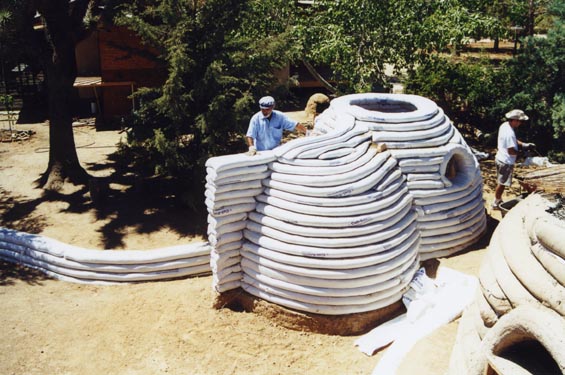(Part of the No Sweat Solutions series.)
 In my last post on material intensity, I mentioned green building as an example of how to indirectly reduce greenhouse gas emissions, before building one wind turbine or making one factory more efficient. Because green building is more familiar than most types of material intensity reduction, I’ll use it for my first examples.
In my last post on material intensity, I mentioned green building as an example of how to indirectly reduce greenhouse gas emissions, before building one wind turbine or making one factory more efficient. Because green building is more familiar than most types of material intensity reduction, I’ll use it for my first examples.
After all, building construction worldwide uses about 40% of mineral and metal products, and 25% of forest products*. And we have experts in green building on this blog who can comment on the examples that follow.
Let’s start with “super-block” or “super-adobe” construction, invented by Nader Khalili, California architect/author and founder of the Hesperia, California-based Cal Earth Institute. It is similar to rammed earth: Wet soil under pressure (mixed with a little cement) turns into a sturdy and long-lasting building material. Khalili’s innovation is to pump the soil into bags that are continuous coils and bind them with barbed wire.

These small changes accomplish big things. The bags and steel reinforcement make the results proof against earthquakes, a way to avoid devastation such as regularly occurs in Iran. The steel wire adds tremendous amounts of tensional and shear strength — something lacking in many traditional forms of earth-based construction. Because the bags are a continuous loop, you may fill them by machine instead of by hand, reducing construction labor to something comparable to traditional stick-built construction.
The steel in the barbed wire is less than the steel in nails used for traditional wood-frame buildings. There is less plastic in the sandbags than in the vapor barriers often used in conventional construction. There is less cement mixed in with the sub-soil dirt than is typically used in normal foundations, probably less than is often used in internal plastering alone. And since the bulk of the home is built from on-site dirt, you don’t need to truck in huge amounts of construction material.
Further, the only machinery used for the foundation and shell phase of construction is digging out the subsoil dirt and pumping it into the bags. This technique can be used for the entire rough shell — foundation, floor, walls, roof, even rough cabinetry and built-in furniture. It can then be insulated and finished by conventional or low-impact techniques, as you please.
Super adobe is sturdy and durable — an earthquake-safe variation on a technique that has been know to last centuries in Iran. How sturdy? In Hesperia, the consultants who tested one for earthquake safety still don’t know the limits of super-bloc strength. They intended to test one to destruction, but their bulldozer was not powerful enough to destroy it, no matter how hard they tried.
That Khalili is a poet as well as an architect probably influenced his choice of materials. He himself has said that he likes the fact that sandbags and barbed wire, often instruments of war, are used to create beautiful spaces for people to live in.
Think about the embedded energy saved by this technique — reductions in steel, plastic, cement, and wood boards. It saves the power needed to transport these things, along with construction electricity and fuel. Durability means you replace buildings less often — more conservation; all this occurs before you have made one mill, factory, or plant more efficient.
Of course there are plenty of buts with this technique. It more or less depends on curves –domes, vaults, arches, and so on. That is not going to fit in with your average suburban neighborhood. It is not suitable for buildings over a couple of stories. And of course it is not a recognized technique. It cannot be used to its full technical potential until building codes recognize it. At the moment, any super-adobe building has to jump through the usual experimental techniques hoop — basically convincing one building department at a time.
So it is a nibble rather than a bite. Still, this is how global warming will be solved — adding up many little things rather than doing one or two big things. And the potential is significant. The story limitation is not a major problem; a high percentage of new U.S. buildings are one or two stories high. Laws can be changed. The visual appearance is harder to get around, but there are always rural areas where your neighbor does not care what your building looks like. There are also heterogeneous areas where something unconventional and dramatic will fit; also, there is more leeway for the unusual looking in commercial buildings than in residential; and many of them are one or two stories.
Lastly, there is the potential to use super-adobe to construct building parts. For example, if it really works as well as concrete in foundations for one and two story buildings, that is a huge potential savings in Portland cement. Similarly, while making a building entirely in the form of vaults or domes and curved structure is probably going to look weird in most neighborhoods, you can fit a vault or dome as one element in a rectangular structure. Even in my little town, if you go into the area where mansions congregate up in Tumwater, you can see rich folks homes that incorporate domes and other curves just for the drama.
—–
* Roodman, David Malin and Nicholas Lenssen, Worldwatch Paper #124: A Building Revolution: How Ecology and Health Concerns Are Transforming Construction. Single Page Summary of Book, March 1995, Worldwatch Institute, 22/Aug/2005 . (Note: one page summary, not entire 67 page paper.)
 In my
In my 
